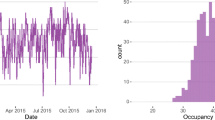Abstract
Although many previous analytical studies indicate that physicians' assistants can substantially increase productivity and reduce costs, the utilization of physicians' assistants in ambulatory health care settings has grown at a disappointing rate. This apparent discrepancy may be explained in part through close examination of the models used in the analytical studies. This paper describes the limitations of previous studies and shows how analysis can be improved through the use of a combined optimization-simulation model. The model is applied to a hypothetical example to demonstrate how productivity and income benefits can be overstated, and to test the sensitivity of such benefits to a range of management policies for the ambulatory care practice regarding patient load, physical resources, appointment scheduling, and more flexible assignment of providers to patients.
Similar content being viewed by others
References
Appel, G., and Lowin, A.,Physician Extenders: An Evaluation of Policy-Related Research. Interstudy, Minneapolis, January 1975.
Golladay, F. L., Miller, M., and Smith, K. R., Allied health manpower strategies: Estimates of the potential gains from efficient task delegation.Med. Care, 11(6):457–469, 1973.
Golladay, F. L., Smith, K. R., Davenport, E., Hansen, M., and Over, M., Policy planning for the midlevel health worker: Economic potential and barriers to change.Inquiry March: 80–89, 1976.
Golladay, F. L., Manser, M. E., and Smith, K. R., Scale economies in the delivery of medical care: A mixed integer programming analysis of efficient manpower utilization.J. Hum. Resources 9(1):50–62, 1974.
Kilpatrick, K. E., MacKenzie, R. S., and Delany, A. G., Expanded function auxiliaries in general dentistry: A computer simulation.Health Serv. Res. 7(4):288–300, 1972.
Kilpatrick, K. E., Implications of new manpower technology for medical and dental practice: A computer simulation analysis. Technical Report Number 20, Health Services Research Division, J. Hillis Miller Health Center, University of Florida, 1974.
Kropp D. H., and Carlson, R. C., Recursive modeling of ambulatory health care settings.J. Med. Syst. 1(2):123–135, 1977.
Lairson, P. D., Record, J. C., and James, J. C., Physician assistants at Kaiser: Distinctive patterns of practice.Inquiry September: 207–219, 1974.
Lazarus, S. S., Wilhoite, D. H., Johnson, K. G., Jacobs, A. R., and Lynn, W. R.,The use of a simulation model for investigating the delegation of ambulatory patient care to physician's assistants. Paper presented at the 45th ORSA/TIMS National Meetings, Boston, Massachusetts, April 1974.
Perry, H. B., III, Physician assistants: An overview of an emerging health profession.Med. Care 15(12):982–990, 1977.
Pondy, L., Jones, J., and Braun, J., Utilization and productivity of the Duke physician's associate.Socio-Economic Planning Sciences 7(4):327–352, 1973.
Reinhardt, U. E., A production function for physician services.Rev. Econ. Stat. 54(1):55–66, 1972.
Reinhardt, U. E., Manpower substitution and productivity in medical practice: A review of research.Health Serv. Res. 8(3):200–227, 1973.
Riddick, F. A., Bryan, J. B., Gershenson, M. I., and Costello, A. C., Use of allied health professionals in internists' offices.Arch. Intern. Med. 127(5):924–931, 1971.
Schneider, D. P., and Kilpatrick, K. E., An optimum manpower utilization model for health maintenance organizations.Oper. Res. 23(5):869–889, 1975.
Smith, K. R., Miller, M. and Golladay, F. L., An analysis of the optimal use of inputs in the production of medical services.J. Hum. Resources 7:208–225, 1972.
Smith, K. R., Over, A. M., Hansen, M. F., Golladay, F. L., and Davenport, E. J., An analytic framework and measurement strategy for investigating optimal staffing in medical practice.Oper. Res. 24(5):815–841, 1976.
Uyeno, D. H., Health manpower systems: An application of simulation to the design of primary health care teams.Manage. Sci. 20(6):981–989, 1974.
Yankauer, A., Schneider, J., Jones, S. J., Hellman, L. M., and Feldman, J. J., Physician output and task delegation in obstetric-gynecologic practices in the U.S.Obstet. Gynecol. 31:151–165, 1972.
Zeckhauser, R., and Eliastam, M., The productivity potential of the physician assistant.J. Hum. Resources 9(1):95–116, 1974.
Author information
Authors and Affiliations
Rights and permissions
About this article
Cite this article
Hershey, J.C., Kropp, D.H. & Kuhn, I.M. The productivity potential of physicians' assistants. J Med Syst 2, 123–138 (1978). https://doi.org/10.1007/BF02222313
Issue Date:
DOI: https://doi.org/10.1007/BF02222313




